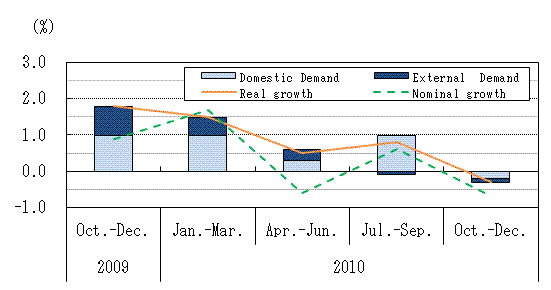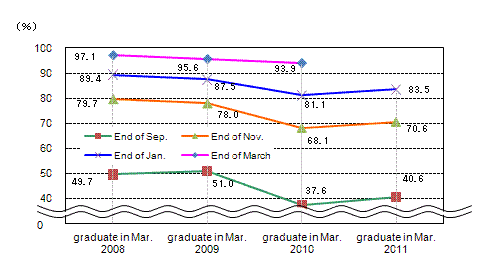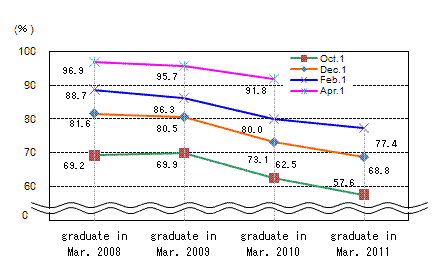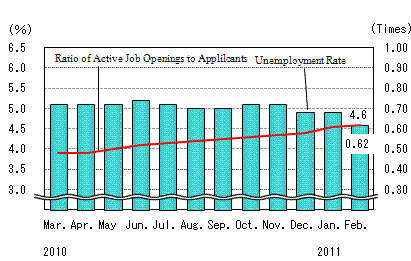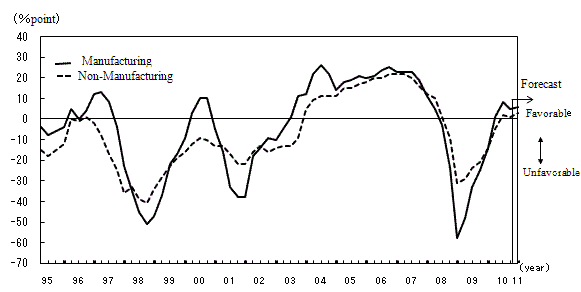Recent Statistical Survey Reports, March 2011
Statistical Survey Reports
Indexes of Business Conditions (Preliminary Report for January)
Monday, March 7, released by the Cabinet Office
The Coincident Index of Composite Index (CI, preliminary figures, 2005=100) in January was 106.2, increased for 3 consecutive months, an increase of 2.5 points. And 3 months backward moving average increased for 2 consecutive months, an increase of 1.83 points, and 7 months backward moving average increased for 3 consecutive months, an increase of 0.54 points. So the Assessment of Coincident Index was "Weakening, but it also shows movements toward "Improving". The Leading Index was 101.9, an increase of 0.9 points for 3 consecutive months, and the Lagging Index was 87.8, a decrease of 1.0 points for the first time in 2 months.
National Accounts (The 2nd Preliminary Estimates Oct.-Dec. 2010)
Thursday, March 10, released by the Cabinet Office![]()
Real GDP (Gross Domestic Product) growth rate (Seasonally Adjusted) was -0.3% (-1.3% on annual basis), unchanged from the 1st preliminary estimates (annual basis, a decrease of 0.2 points from the 1st preliminary estimates).
Of real GDP growth rate, -0.2% was contributed by domestic demand and -0.1% by external demand.
Quartely Estimates of GDP: Oct. ~Dec. 2010 (The 2nd Preliminary Estimates)
Growth rate of GDP from the previous Quarters(seasonally adjusted)
Contributions of Domestic Demand and External Demand to Changes in GDP
8th Longitudinal Survey of Adults in 21st Century (Continuous Survey on the livelihoods of the Japanese citizens)
Wednesday, March 16, released by the Ministry of Health, Labour and Welfare
As for the ratio (average of these 7 years) of men and women who were unmarried in the survey (2002-2008) and got married by the next survey, by employment type, about men, “regular (*)” accounted for 6.3%, “non-regular(*)” 2.1% and about women, “regular” accounted for 7.7%, “non-regular”5.7%. The ratio that regular employees got married is higher than that of non-regular employees.
(*) regular: regular employees, Non-regular: non-regular employees; temporary worker, part-time worker, dispatched worker from temporary labour agency, contracts or entrusted employee and other
As for women who are age 20-34 in 2002 and got married in these seven years(2003-2009), the change of their employment situations between before and after the marriage, “continuing the same job” for “regular” was 64.3%, “having left the job” was 26.4% and so on. On the other hand, for “non-regular”, “continuing the same job” was 44.5%, “having left the job” was 39.3% and so on.
As for married couples where children were born in these six years (2004-2009) and whose wife had been working as employees before she gave birth, the ratio of continuing the job of her after giving birth by employment type and existence utilizable childcare leave system, for “regular” “the system is available” was 76.1% and “the system is not available” was 22.2%. For “non-regular” “available” was 37.5% and “not available” was 15.7%.
Survey on Situation of Preliminary Job Offers for New Graduate (Senior and Junior High School) (End of January, 2011)
Friday, March 18, released by the Ministry of Health, Labour and Welfare
The ratio of final-year senior high school students with preliminary job offers was 83.5%, an increase of 2.4 points from the same period of the previous year.
The ratio of job openings to applicants for final-year senior high school students was 1.15, 0.02 points lower than the same period of the previous year.
The ratio of job openings to applicants for final-year junior high school students was 0.63, 0.03 points higher than the same period of the previous year.
Trend in the percentage of final-year high school students
with official job offer
Survey on Situation of Preliminary Job Offers for New Graduate in Mar.2011 (University, etc.) (February 1, 2011)
Friday, March 18, released by the Ministry of Health, Labour and Welfare
The ratio of final-year university students who got an official job offer to applicants was 77.4%, decreased by 2.6 points from the same period a year earlier.
That of final-year junior college students (female only) was 63.1%, decreased by 4.2 points from the same period a year earlier.
That of final-year technology college students (male only) was 97.3%, unchanged from the same period a year earlier.
That of final-year vocational school students was 69.5%, decreased by 2.9 points from the same period a year earlier.
Trend in the percentage of final-year university students
with official job offer
Consumer Price Index (February)
Friday, March 25, released by the Ministry of Internal Affairs and Communications
The Consumer Price Index was 99.3, unchanged from the same month the year before. Omitting Fresh food, the comprehensive index was 98.9, a decrease of 0.3% from the same month the year before, decreased for 24 consecutive months.
And in the ward -areas of Tokyo in March (preliminary report), the former accounted for 98.7, a decrease of 0.3% from the same month the year before. The latter accounted for 98.6, a decrease of 0.3% from the same month the year before.
Family Income and Expenditure Survey (February)
Tuesday, March 29, released by the Ministry of Internal Affairs and Communications
The average monthly income for a worker's household with 2 or more family members was increased by 1.0% in real terms from the same month a year before.
With regard to the income contributing to increase - decrease rate, contribution of income earned by head of household accounted for -1.90 %, partner's income accounted for -0.80%, other household members' income accounted for 0.37%, social security benefits(*) accounted for 4.45% and so on.
(*)Including child allowance for the 4 months up to the month prior to payment.
Labour Force Survey (February)(*)
Tuesday, March 29, released by the Ministry of Internal Affairs and Communications
The unemployment rate (seasonally adjusted) was 4.6%, decreased by 0.3 point from the previous month. That for men was 4.8%, decreased by 0.5 point from the previous month and that for women was 4.3%, increased by 0.1 point from the previous month.
The number of unemployed persons (seasonally adjusted) was 3.03 million, decreased by 190 thousand from the previous month.
The number of employees (seasonally adjusted) increased by 480 thousand from the previous month to 55.39 million.
(*)Figures are tentative, because results of whole Japan are estimated without questionnaires from devastated quake-hit prefectures (Iwate, Miyagi and Fukushima).
Report on Employment Service (February)
Tuesday, March 29, released by the Ministry of Health, Labour and Welfare
The ratio of active job openings to applicants (seasonally adjusted) was 0.62, increased by 0.01 point from the previous month.
Trend in Unemployment Rate and Ratio of Active Job
Openings to Applicants(seasonally adjusted)
Indices of Industrial Production (February)
Wednesday, March 30, released by the Ministry of Economy, Trade and Industry
The index of industrial production (seasonally adjusted) increased by 0.4% from the previous month.
According to the Survey of Production Forecast in Manufacturing, Production is expected to increase in March and decrease in April. The Synthetic judgment is “Industrial Production continues to show an upward movement. However, it would be necessary to keep watch on the impact of the Tohoku-Pacific Ocean Earthquake on the production.”
Monthly Labour Survey (Preliminary Report in February / Year-end bonus)
Thursday, March 31, released by the Ministry of Health, Labour and Welfare
Total amount of cash earnings (for business establishments with 5 or more employees) increased by 0.3% from a year earlier, and contractual cash earnings decreased by 0.1% from a year earlier.
Scheduled cash earnings decreased by 0.3%, non-scheduled cash earnings increased by 3.5%, and special cash earnings increased by 31.1% from a year earlier. Real wage (total) increased by 0.1% from a year earlier.
Non-scheduled hours worked by manufacturing industry workers at business establishments with 5 or more employees increased by 2.5% from the previous month (seasonally adjusted).
The amount of year-end bonus in 2010 (for business establishments with 5 or more employees) was 379,292yen, decreased by 0.3% from the previous year. The ratio of number of business establishments which paid year- end bonus was 70.1%, decreased by 0.5% from a year earlier.
Monthly Survey on Service Industries (Preliminary Report in January)
Thursday, March 31, released by the Ministry
of Internal Affairs and Communications
(PDF:150KB)![]()
The monthly sales amount of service industry in January 2011 was 21 trillion yen, a decrease of 4.9 % from the same month the year before. The total number of persons employed in the industry was 25.19 million, a decrease of 2.9% from the same month the year before. Among the service industry, the monthly sales amount of employment placement and worker dispatching business was 302.728 billion yen, an increase of 6.9% from the same month the year before, and the number of persons employed totaled 189 thousand, a decrease of 21.5% from the same month the year before.
TANKAN (Short-Term Economic Survey of Enterprises) (March)
Friday, April 1, released by the Bank of Japan(PDF:192KB)![]()
The Diffusion Index (DI) (“Favorable”- “Unfavorable”) for business conditions in large enterprises of the manufacturing was 6 (5 in the previous quarter and forecast 2 in the coming quarter), and the non-manufacturing DI was 3 (1 in the previous quarter and forecast -1 in the coming quarter).
The DI of the manufacturing was 7 (3 in the coming quarter) (before the earthquake) and 6 (-2 in the coming quarter) (after the earthquake). And the DI of the non-manufacturing was 1 (0 in the coming quarter) (before the earthquake) and 7 (-4 in the coming quarter) (after the earthquake).
The Diffusion Index (DI) (“Excessive”- “Insufficient”) for employment conditions in large enterprises of all industries was 4 (6 in the previous quarter and forecast 5 in the coming quarter).
(*)As the Tohoku - Pacific Ocean Earthquake occurred on March 11, the situation--in which the sample
enterprises complete the survey form--has changed significantly. Under such extraordinary circumstances, the Bank has decided to release reference data for the Diffusion Index of "Business Conditions" in two parts: (1) aggregates of the survey form returned to the Bank from February 24 to March 11 (referred to as "Before the earthquake"), and (2) aggregates of the survey form returned to the Bank from March 12 to March 31 (referred to as "After the earthquake").
Business Sentiment(For Large Enterprise)
Other Reports
Monthly Economic Report (March)
Wednesday, March 23, released by the Cabinet Office![]()
Although the Japanese economy is turning to pick up, it is only weakly self-sustaining and the influence of the Tohoku - Pacific Ocean Earthquake is concerned. Also,it remains in a difficult situation such as a high unemployment rate. (In the previous month, “The Japanese economy is showing movements towards a pickup and emerging from a recent pause in activity. However,”)
- Exports are showing movements of picking up. Industrial production has picked up, but the influence of the Tohoku - Pacific Ocean Earthquake is concerned.(In the previous month, “Exports and industrial production are showing movements of picking up.”)
- Corporate profits are improving. Business investment is picking up. (The same as the previous month)
- Firms' judgment on current business conditions shows a sign of caution. (The same as the previous month)
- While the employment situation remains severe, movements of an incipient recovery can be seen. (The same as the previous month)
- Private consumption is almost flat recently. (The same as the previous month)
- Recent price developments show that the Japanese economy is in a mild deflationary phase. (The same as the previous month)
Monthly Economic Labour Report (March)
Thursday, March 24, released by the Ministry of Health, Labour and Welfare
In looking at the aspects of labour and economy, while the employment situation remains severe, movements of an incipient recovery can be seen. (The same as the previous month)
| To view PDF files, you will need Adobe Acrobat Reader Software installed on your computer.The Adobe Acrobat Reader can be downloaded from this banner. |

